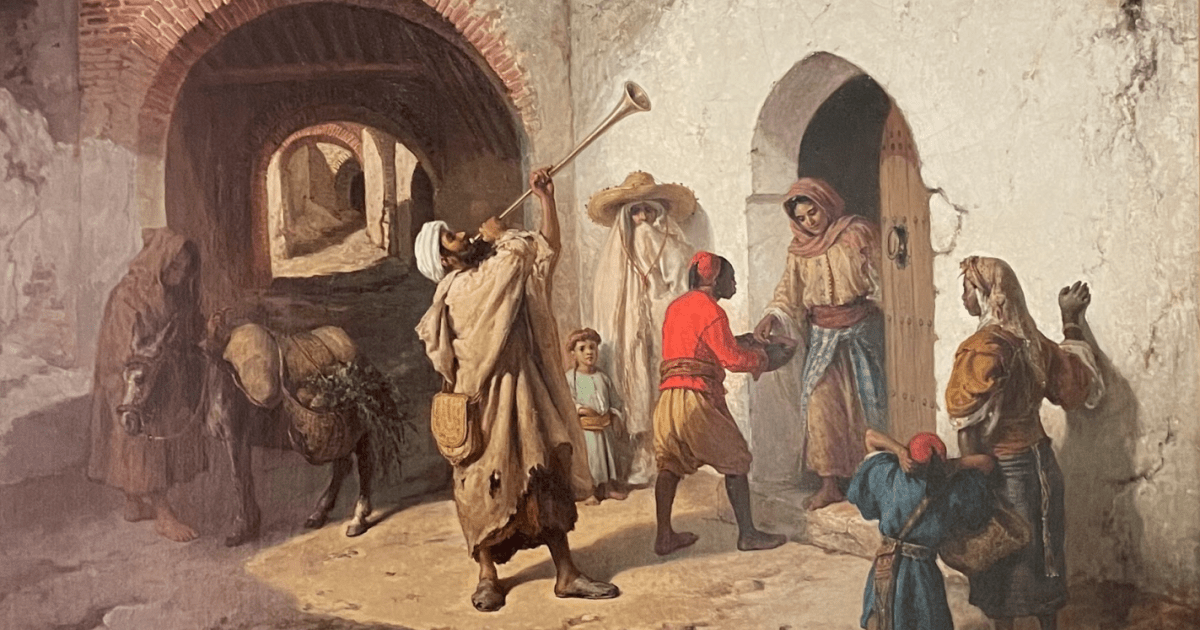Rabat-
As soon as the crescent moon of the month of Ramadan was announced in Morocco, a player in his traditional robes and red fez appears on public television, playing special Ramadan music with a sharp brass wind instrument.
The melodies of the horn player or the boujel herald the arrival of a dear guest who has a great status among Moroccans, who they call “Our Master Ramadan.”
The music he plays is borrowed from Moroccan invocations associated with the dawn prayer called Tahlal, and one of its most famous words is “Oh servants of God, rise, do not sleep, this is the time of goodness.
These supplications - which are broadcast on the radio in Ramadan and music is played with their melody - are part of the details of Ramadan in this kingdom, and its manifestations are not complete without its presence.
Authentic Maqamat
Mohsen Nourch explains that the Moroccan emotional memory is associated with prayers, especially in Ramadan, when people stay awake until dawn prayers and then listen to these prayers from above the mosques and through local radio stations.
The crescents consist of prayers and poems performed by the muhalal from the hermitages before the dawn prayer, beginning with a slow melody and then accelerating as the dawn call to prayer approaches.
And Al-Muttahl - says Norsh - wanders through authentic shrines, including the Hijaz, Rasd, Sand Al-Mayah and Ghariba Al-Hussain, which concludes with the words, "O servants of God, rise, do not sleep, this is the time of goodness, rise and gain."
Despite the similarity in the melodies and melodies, the words differ from one worshiper to another, and they choose them from the extended poems of the great men of Sufism.
And part of the details of life in the old cities began to shine, as Norsh explains that in the past, it used to start 3 hours before dawn to sympathize with patients and strangers, where the pilgrim shares intimate and touching moments with the residents of the neighborhood with his dewy voice.
He pointed out that the Moroccans have allocated endowments, the income of which goes to reward the pilgrims in the silos.
However, people pay more attention to these supplications in Ramadan, when they stay awake until the time of imsak and dawn prayer.
Among the most famous cheerleaders were Haji Muhammad al-Omari, who used to present chants in his voice on the national radio, and Abd al-Ghani al-Faqir, Abd al-Hamid Abouleish and Moulay Abd al-Salam al-Shibhi.
Historical sources indicate that the custom of chanting poems and reciting dhikrs above the mosques, before the dawn call to prayer and on the nights of Ramadan, was known in the 15th century Watts as the era.
Immortal songs
Every Ramadan, singers and vocalists strive to produce songs for this religious occasion, but it was not able to remove some of the old songs that were associated in the conscience with this holy month and became part of the basic manifestations that furnish, along with other details, the complete picture and the complete scene of the blessed Ramadan.
In Egypt, the song “Wahwi Ya Wa Hawi” is one of the most famous and oldest songs that have been associated in the conscience and memory of Egyptians and Arabs with Ramadan, and its words mean a feeling of joy at the arrival and seeing of a loved one.
This song, which was presented for the first time in 1937, remained alive and continuous and related to this holy month, and it was written by Muhammad Helmy Al-Manasterly, composed by Ahmed Sharif and sung by Ahmed Abdel Qader.
Her words say, "And oh, oh, oh, oh, oh, oh, oh, oh, oh, oh, oh, oh, oh, oh, oh, oh, oh, oh, oh, oh, oh, oh, Ramadan."
Alongside her is "Ramadan Jana", one of the most prominent songs that spread joy and express happiness in welcoming Ramadan, sung by the late artist Mohamed Abdel Muttalib, the words of Hussein Tantawi and composed by Mahmoud Al Sharif, and it was broadcast for the first time on Egyptian TV in 1965.
The lyrics of the song read, "Ramadan Jana, and we rejoiced in him, after his absence and grocery time, they sang with us a long month, sang and said hello Ramadan."
In Lebanon, the song "Ola Al Bayariq" has a deep place in the conscience. Its lyrics and melody were written by the artist Ahmed Kaabour, in the mid-eighties of the last century.
The song became a Ramadan anthem circulated by the people and the media on this religious occasion, and the words of its introduction say, "Raise the banners high and sing for the feast, lit the streets, let them sing again."
In Tunisia, the prayers of the artist Lotfi Bushnak remain essential in Ramadan, the most famous of which is the "Asmaa Allah Al-Hosni" prayer, which is shown on Tunisian channels and radio stations before the call to prayer and is linked to the holy month, along with other prayers for it.

